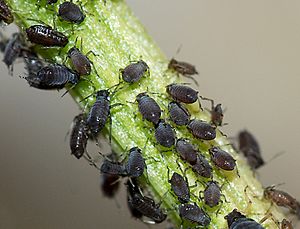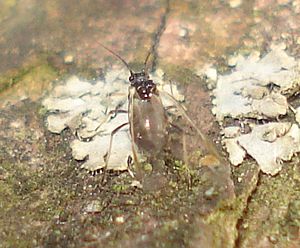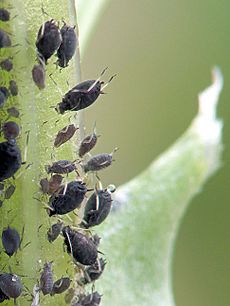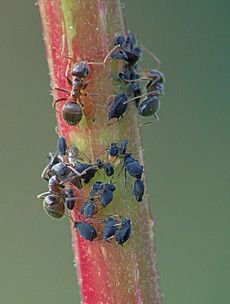Black bean aphid facts for kids
Quick facts for kids Aphis fabae |
|
|---|---|
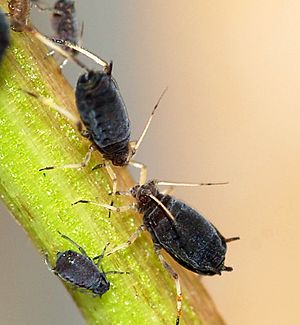 |
|
| Two wingless adults and a nymph | |
| Scientific classification | |
| Genus: |
Aphis
|
| Species: |
fabae
|
The black bean aphid (Aphis fabae) is a tiny black insect. It has a soft, round body. People also call it blackfly, bean aphid, or beet leaf aphid. These aphids belong to a group of insects called Hemiptera.
During warmer months, you can find many black bean aphids. They gather on the underside of leaves and on the growing tips of plants. These plants include farm crops, wild plants, and garden plants. Both winged and wingless aphids exist. At this time of year, they are all females.
Black bean aphids suck sap from plant stems and leaves. This can make the shoots look twisted and the plants grow slowly. It also means fewer crops or spoiled crops. These aphids can also spread viruses that make plants sick. They produce a sticky, sweet liquid called honeydew. This honeydew can lead to a black, fuzzy mold called sooty mould growing on plants.
Aphids reproduce very quickly by giving live birth. However, other insects help control their numbers. These include insects that hunt aphids or lay eggs inside them. Ants like to eat the honeydew from aphids. Because of this, ants often protect aphids from their enemies. The black bean aphid is a common pest in farming areas. Farmers can control them using chemicals or natural methods. In autumn, winged aphids fly to different plants. There, both male and female aphids are born. They mate, and the females lay eggs that survive the winter.
Contents
About the Black Bean Aphid
The scientific name for the black bean aphid is Aphis fabae. The word fabae comes from the Latin word for "bean." This is because these aphids often eat bean plants. The black bean aphid is part of a larger group called Aphidoidea.
Some scientists think that Aphis fabae might actually be a group of very similar types of aphids.
What Black Bean Aphids Look Like
The black bean aphid is a small insect with a soft body. It has special mouthparts that are like tiny straws. It uses these to suck juice from plants. You usually see many of these tiny, plump insects together. They are about two millimeters long. They have a small head and a round body. Their bodies are black or dark green.
Many adult aphids do not have wings. These are called wingless aphids. Winged aphids are longer and thinner. They have shiny black heads and chests. Their clear wings fold over their bodies. Their antennae are shorter than two-thirds of their body length. Both their antennae and legs are pale yellow with black tips.
Near the back of their bodies, aphids have two thin tubes. These are called cornicles. They make a waxy liquid that helps protect the aphid. These tubes are twice as long as their small, finger-like tail. Both the tubes and the tail are brownish-black.
Black Bean Aphid Life Cycle
The black bean aphid has a complex life cycle. It includes both sexual and asexual reproduction. It also moves between different types of plants during the year.
In autumn, winged female aphids lay eggs on woody shrubs. These shrubs are called primary host plants. The adult aphids then die, and the eggs stay on the plants through the winter. In spring, wingless females hatch from these eggs. These are called stem mothers. They can reproduce without mating. They give birth to live young, called nymphs. This is called parthenogenesis.
A female aphid that reproduces this way lives for about 50 days. During this time, she can have up to 30 babies. These babies are also females. They can also reproduce without mating. However, later generations often grow wings. These winged aphids then fly to different plants. These are called secondary host plants. They are usually soft, leafy plants with new growth.
More asexual reproduction happens on these new plants. Aphids gather on the undersides of leaves and on growing tips. All the offspring are female during this time of year. Large groups of aphids grow quickly throughout the summer. Both winged and wingless aphids are born. Winged aphids develop when there are too many aphids in one place. They then fly to new plants or crops.
By mid-summer, many insects that eat or parasitize aphids have appeared. This helps stop the aphid population from growing. As autumn gets closer, the winged aphids fly back to the primary host plants. There, both male and sexual female aphids are born without mating. They then mate, and these females lay eggs in cracks or under lichens. This completes the life cycle. Each female can lay six to ten black eggs. These eggs can survive very cold temperatures. More than 40% of the eggs usually survive the winter. However, some are eaten by birds or other insects, and some do not hatch in spring.
Where Black Bean Aphids Live and What They Eat
The black bean aphid can eat many different kinds of plants. The main plants where their eggs spend the winter are shrubs. These include the spindle tree (Euonymus europaeus), Viburnum species, or the mock-orange (Philadelphus species).
The plants they live on during the summer are called secondary hosts. These include many farm crops. Some examples are sugar beets, spinach, beans, runner beans, celery, potatoes, sunflowers, carrots, and tomatoes. They can live on over 200 different types of farmed and wild plants. Among wild plants, they prefer poppies (Papaver species), burdock (Arctium tomentonum), and thistles (Cirsium arvense).
Aphids choose their host plants based on the type of plant and how old its leaves are. For example, winged aphids move between spindle and beet leaves. They choose based on which plant is actively growing. In late summer, beet leaves are old and not appealing to aphids. But spindle leaves are more attractive. In spring, the new beet leaves are more appealing than spindle leaves.
Damage Caused by Black Bean Aphids
The black bean aphid is a big problem for sugar beet, bean, and celery crops. Large numbers of aphids can make plants stop growing. Beans can have damaged flowers and pods that do not grow well. If crops are planted early, they might flower before many aphids appear. This can help them avoid serious damage. Celery plants can get very infested.
Aphids suck sap from plants, which makes them grow slowly. Stems can become twisted. Aphids also spread harmful plant viruses. Their sticky honeydew can make the crop dirty.
When sugar beet plants are infested, their leaves swell, curl up, and stop growing. The roots do not grow well, and the sugar content in the beets goes down. In some other plants, the leaves do not twist. But growth is still affected, and flowers may fall off. This happens because of a toxic liquid the aphid injects. This liquid helps the sap flow better.
Aphids need to suck a lot of sap to get enough protein. They then release the extra sugary liquid as honeydew. This honeydew sticks to plants. It helps black sooty molds grow. These molds look bad and cover the plant's surface. This reduces the area available for photosynthesis. It can also lower the value of the crop.
These aphids also spread about 30 different plant viruses. The aphids might not start the infection. But they are very good at spreading the virus through a crop. Farmers can use chemicals to kill aphids. Farmers who grow organic crops can use a solution of soft soap.
Aphids and Other Animals
Natural enemies of black bean aphids include ladybirds and lacewings. Both adult ladybirds and their young eat aphids. The young of hoverflies also eat aphids. Some tiny wasps are also enemies of aphids. These wasps lay their eggs inside aphids. The young wasp larvae then eat the aphid from the inside. Wasps from the groups Diaeretiella and Lysiphlebus do this. They can help control aphid numbers.
Ants climb plants to eat the honeydew that aphids produce. Many types of ants have learned to protect and encourage their aphids. For example, black garden ants (Lasius niger) remove predators like ladybirds from near the aphids. This keeps their "milk cows" safe. In one study, bean plants without aphids produced 56 seeds per plant. Plants with aphids but no ants produced 17 seeds. But plants with both ants and aphids produced only 8 seeds per plant. This shows how ants can make aphid problems worse for plants.
Where Black Bean Aphids Are Found
The black bean aphid might have first appeared in Europe and Asia. But now it is one of the most common types of aphids. You can find it in many temperate areas. This includes Western Europe, Asia, and North America. It is also found in cooler parts of Africa, the Middle East, and South America. In warmer places, wingless aphids can survive the winter. They might keep reproducing without mating all year long. These aphids are known to travel long distances.
See also
 In Spanish: Aphis fabae para niños
In Spanish: Aphis fabae para niños


